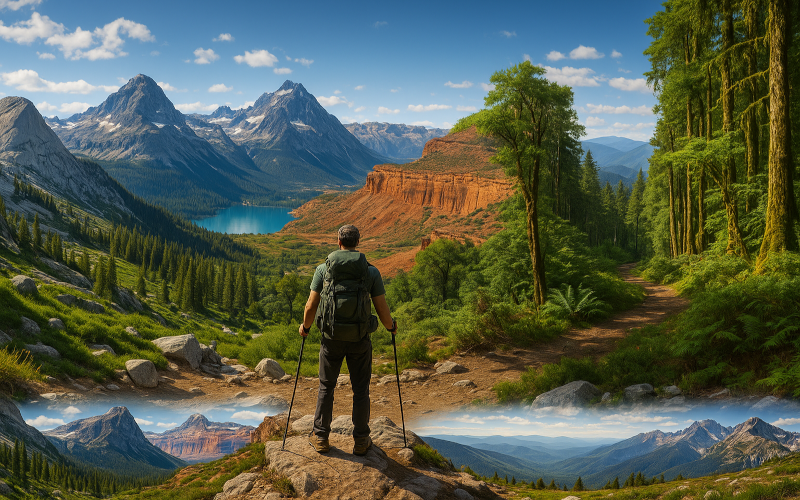
Disclosure: As an Amazon Associate, we earn from qualifying purchases. We may also earn from other affiliate links at no extra cost to you.
The 6 Best U.S. National Parks for Backpacking in 2025 & 2026
Destination-focused picks with permit intel + park-specific packing hacks
Planning note: many parks now use timed-entry or quota systems. Dates and rules can shift year to year; I’ve cited the latest official pages below so you can quickly verify 2026 details as they’re announced.
1) Yosemite National Park, California Granite, High Sierra Lakes, and Classic Loops
Why it’s elite: Iconic granite basins, big passes, and tons of loop options in the High Sierra. Overnight permits are competitive, but the payoff is sublime.
Best for: 2–5 night High Sierra loops (Cathedral Lakes ↔ Vogelsang, Lyell Canyon, Merced Lake basins).
2025 logistics (and what to watch for in 2026):
-
Peak-hours vehicle reservations are required on select 2025 dates (Memorial Day weekend; daily from June 15–Aug 15; Labor Day weekend) for entry 6 a.m.–2 p.m.. Exemptions apply if you have in-park camping/lodging or wilderness permits. Check the official NPS “Entrance Reservations” page and the Recreation.gov ticket for booking windows. (National Park Service, Recreation.gov)
-
Wilderness permits are required for overnight trips; Half Dome day-use permits are a separate lottery when the cables are up (late May–early Oct, weather dependent). (Recreation.gov, National Park Service)
Packing hacks (Yosemite):
-
Bug window: Early–mid summer brings mosquitoes near meadows/lakes pack head net + strong repellant.
-
Granite kitchens: A canister stove + 750–900 ml titanium pot is perfect for fast boils at altitude.
-
Bear storage: Standard bear-canister rules don’t skimp on volume if you’re doing 3+ nights.
-
Footing: Granite slabs + creek crossings → trekking poles save knees and improve balance.
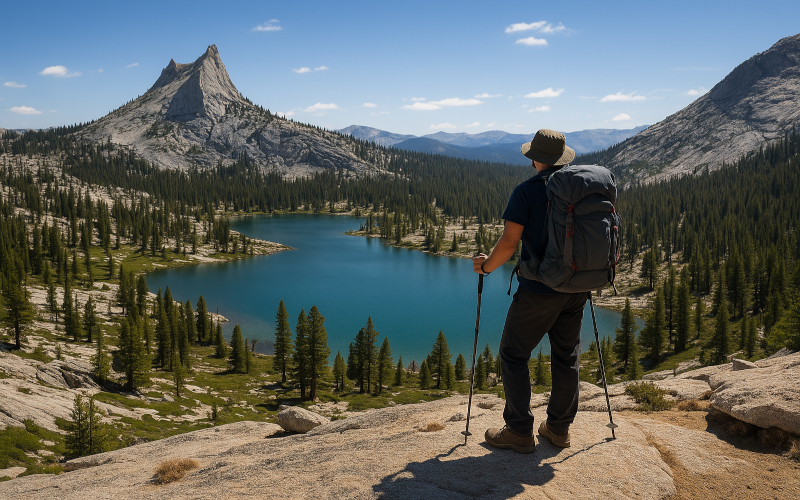
Cathedral Lakes in Yosemite’s High Sierra, alpine basins where a bear canister and bug net are as important as your camera.
2) Glacier National Park, Montana Big Passes, Big Wildlife, 700+ Miles of Trail
Why it’s elite: Long traverses over dramatic passes and turquoise lakes, with designated backcountry campgrounds that make logistics clear (if you score them).
Best for: 3–6 night itineraries linking Many Glacier, Belly River, and Highline/Granite Park areas.
2025 logistics (and 2026 trend):
-
Wilderness camping now uses two early-access lotteries to assign reservation times before you build your itinerary in Recreation.gov. Plan in advance and be flexible with routes. (National Park Service)
-
Vehicle reservations (timed entry) run June 13–Sep 28, 2025 for certain road corridors (e.g., west side of Going-to-the-Sun, North Fork). Expect similar systems to be announced for 2026; always confirm current corridors before booking. (Recreation.gov)
Packing hacks (Glacier):
-
Bear country: Mandatory bear spray; keep a canister or approved food-hang system per campsite rules.
-
Weather whiplash: Hard shell + insulating mid-layer even in July; storms roll fast over the Divide.
-
Feet: Trails can be rocky and long rock plates in shoes or burlier boots help.
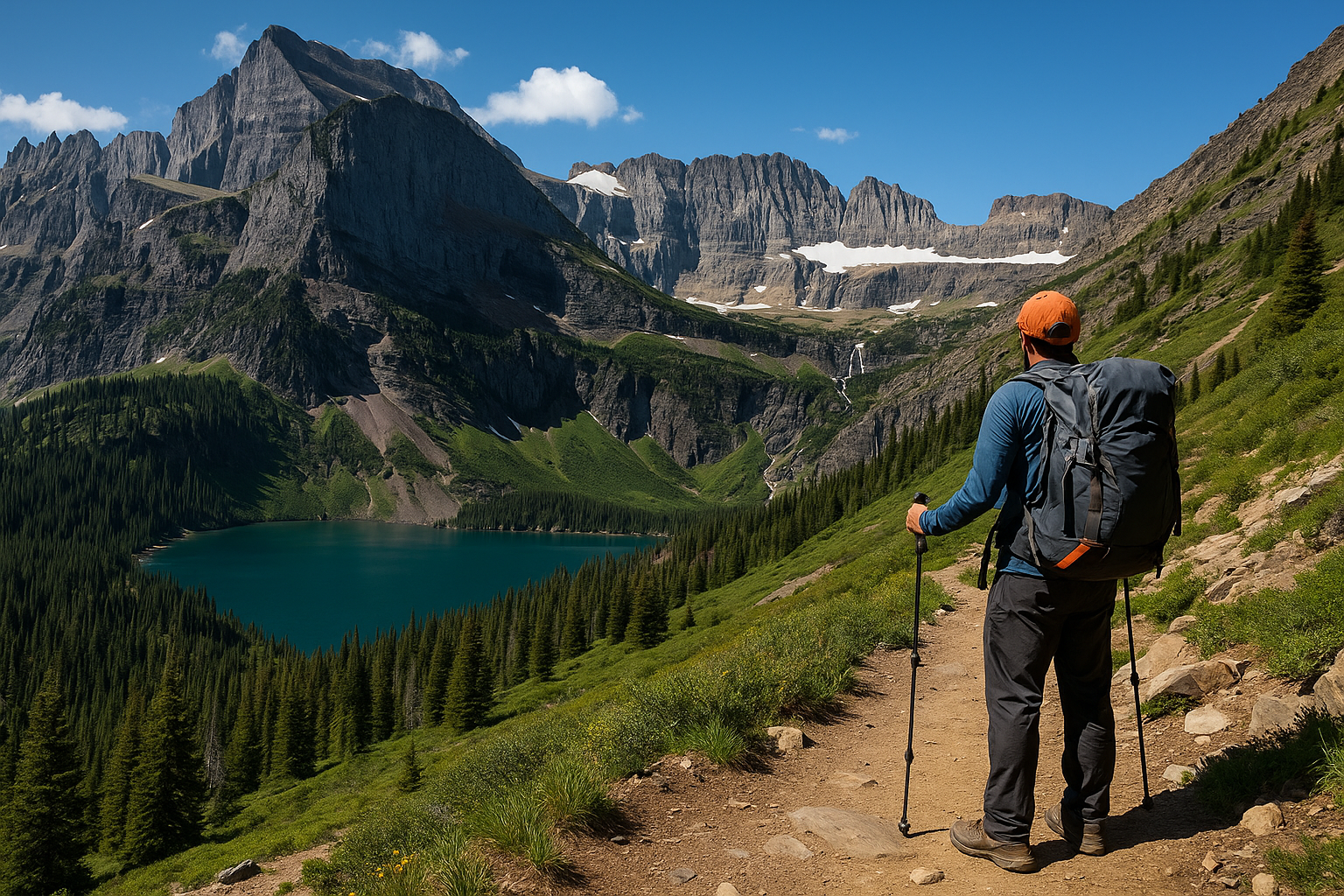
The Highline Trail in Glacier National Park, sweeping ridgelines and alpine lakes reward those who plan ahead for permits and pack bear spray.
3) Grand Canyon National Park, Arizona Desert Corridors, Rims, and the Tonto
Why it’s elite: World-class “rim-to-river” corridors, remote Tonto traverses, and shoulder-season magic.
2025 logistics (read carefully):
-
As of 2025, North Rim is CLOSED for the remainder of the season due to wildfire damage (Dragon Bravo). South Rim access remains the primary gateway. (National Park Service)
-
River Trail (Pipe Creek Beach ↔ Bright Angel Campground) and Plateau Point Trail are closed through Sep 30, 2025 for Trans-Canyon Waterline work; plan corridor itineraries accordingly. (Recreation.gov)
-
Backcountry permits are still required for overnights; check area-specific use and water notes. (National Park Service)
Packing hacks (Grand Canyon):
-
Heat strategy: Electrolytes > plain water; wide-brim hat, UPF sun layers, and 2–4 L capacity.
-
Shoulder seasons: Spring/fall are ideal, but nights can be chilly bring a legit mid-layer.
-
Sand & stone: Durable trail runners or boots; tape your heels early to prevent hot spots.
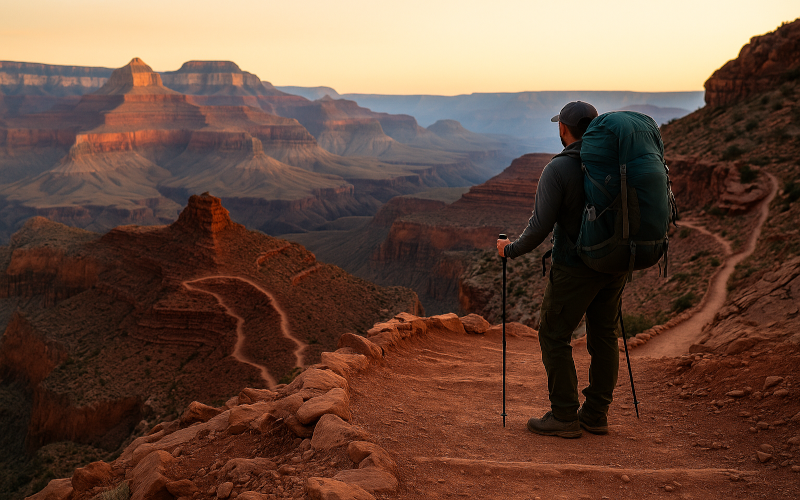
Dawn on the South Kaibab Trail with steep switchbacks, endless views, and a reminder to pack sun protection and plenty of water.
4) Olympic National Park, Washington Rainforests, Coast, and Alpine in One Trip
Why it’s elite: Few places let you weave glacier-fed rivers, old-growth rainforest, and wild beaches into a single multi-day plan like Olympic does.
Best for: 2–5 night loops combining Hoh or Quinault rainforests, Seven Lakes Basin/High Divide, and beach segments like Shi Shi or Ozette.
2025 logistics (expect similar in 2026):
-
Backpacking permits are required year-round and are issued via Recreation.gov. (National Park Service)
-
Bear canisters are required (or strongly recommended) in many zones; canisters are available to borrow from Wilderness Information Centers super handy if you’re flying in. (Recreation.gov)
Packing hacks (Olympic):
-
Moisture management: Synthetic base layers + real rain shell; line your pack with a trash-compactor bag or use dry bags.
-
Beach segments: Tide chart + orange/black headland markers; trail sections can require ladders/ropes pack gloves.
-
Bugs: Early summer can bite head net + repellent.
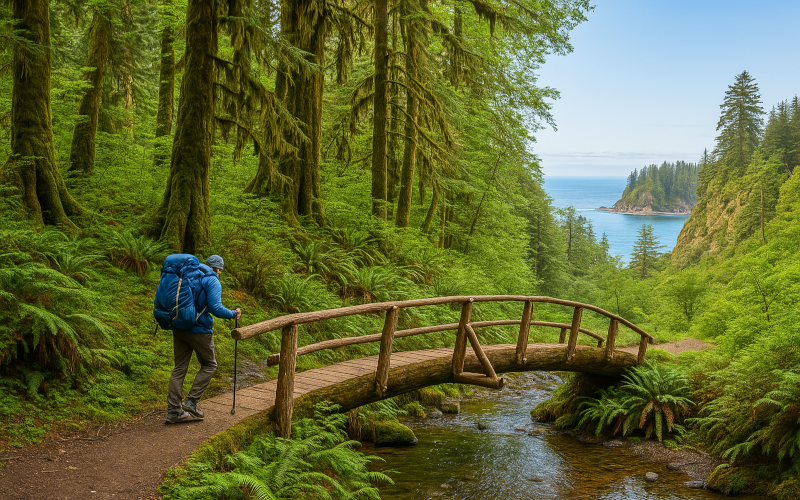
The Hoh Rainforest in Olympic National Park, it's lush, wet, and wild. Pack a real rain shell, dry bags, and tide charts if your trek includes coastal stretches.
5) Great Smoky Mountains National Park, TN/NC Ridgelines, Shelters, and Four Seasons
Why it’s elite: America’s most-visited park still offers excellent multi-day ridge walks and shelter-to-shelter itineraries especially mid-week or shoulder season.
Best for: 2–4 night AT-based loops (Newfound Gap ↔ Mt. LeConte ↔ Kephart) or Deep Creek/Noland Creek basins.
2025 logistics (likely similar in 2026):
-
Backcountry permits and advance reservations are required for all backcountry camping. (National Park Service)
-
A parking tag is required for vehicles parked more than 15 minutes (waived on specific free-days). Plan your tag purchase before you hit the lot. (National Park Service)
Packing hacks (Smokies):
-
Humidity & rain: Prioritize a breathable shell; carry camp socks that never leave the dry bag.
-
Shelters: Even if you plan shelters, bring a light tarp or tent in case of overflow or preference.
-
Critters: Ursines and the ever-present “mini-bears” (mice) use hard canister or perfect your hang.
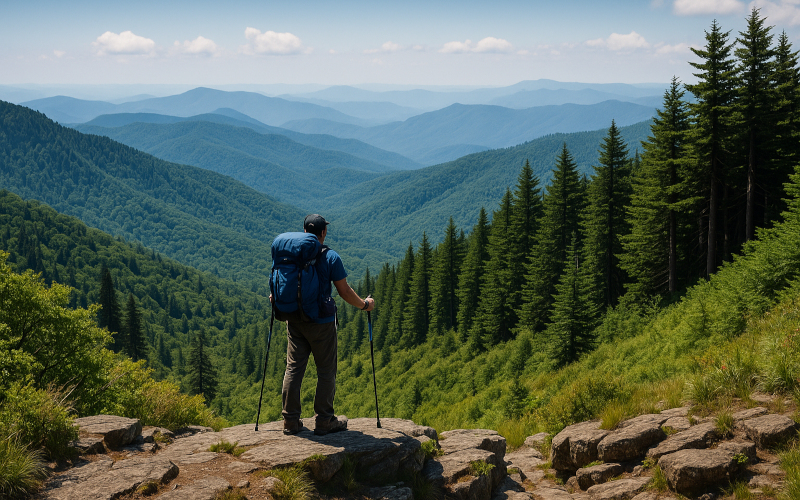
Smoky Mountain ridgelines stretch into forever, pack breathable layers, dry camp socks, and a light tarp for shelter overflow at busy backcountry sites.
6) Sequoia & Kings Canyon (SEKI), California High Sierra Classics Without the Valley Crowds
Why it’s elite: Deep granite canyons, giant sequoias, and access to famous loops (Rae Lakes!) with true wilderness vibes.
Best for: 3–5 night Rae Lakes Loop, Bubbs/Paradise/Deadman Canyons, and long north–south High Sierra traverses.
2025 logistics (watch quota dates for 2026):
-
Quota-season wilderness permits are released on Recreation.gov up to six months in advance; daily releases at 7:00 a.m. Pacific. Quotas apply by entry trailhead. (National Park Service)
-
SEKI permits also support continuous travel into adjacent forests/parks (e.g., Inyo, Yosemite) subject to their conditions handy for big traverses. (Recreation.gov)
Packing hacks (SEKI):
-
High passes: Afternoon thunderstorms are common start early, pack a real shell, and stash light gloves.
-
Water crossings: Late-spring snowmelt can swell creeks trekking poles and water shoes earn their keep.
-
Altitude: Plan a day to acclimate; take it easy the first big climb.
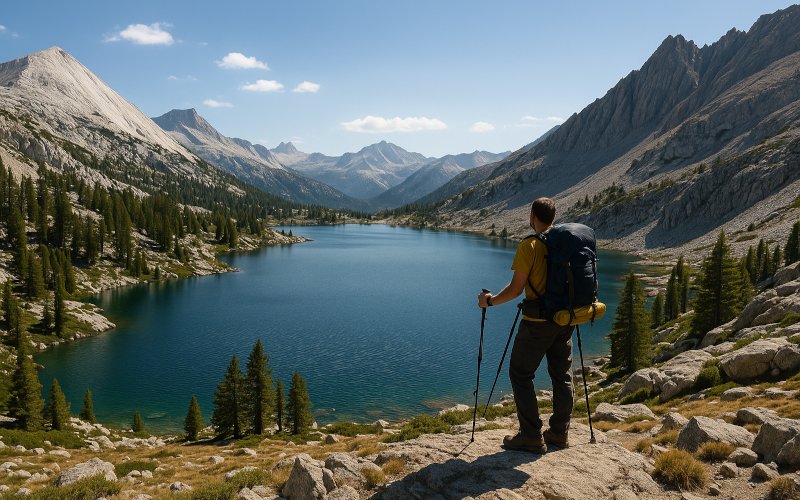
The Rae Lakes Loop in Sequoia-Kings Canyon, classic High Sierra terrain where trekking poles, creek-crossing shoes, and a solid bear canister are non-negotiable.
When to Go (Quick Planner)
-
Desert & Canyon (Grand Canyon): March–May, Oct–Nov for cooler temps; summer requires aggressive heat strategy. (National Park Service)
-
High Sierra (Yosemite, SEKI): Late June–September, with lingering snow possible on high passes in early season; mosquitoes peak early summer. (National Park Service)
-
Northern Rockies (Glacier): July–September for most high routes; snow and road access limit earlier seasons; check any vehicle reservation corridors. (Recreation.gov)
-
Pacific Northwest (Olympic): July–September for alpine; rainforests are viable year-round with true rain gear. (National Park Service)
-
Smokies: Year-round potential; spring wildflowers and fall color are standouts; prepare for humidity and pop-up storms. (National Park Service)
Permit & Entry Cheatsheet (2025 highlights)
-
Yosemite: Peak-hours vehicle reservations on select dates (Memorial Day, June 15–Aug 15, Labor Day). Wilderness permits always required for overnights; Half Dome permits separate. (National Park Service)
-
Glacier: Two early-access lotteries for backcountry reservations; vehicle reservations for certain corridors June 13–Sep 28. (National Park Service, Recreation.gov)
-
Grand Canyon: North Rim closed remainder of 2025 season; River Trail and Plateau Point closed through Sep 30, 2025; backcountry permit required. (National Park Service, Recreation.gov)
-
Olympic: Year-round permits via Recreation.gov; bear canisters often required/loaner program available. (National Park Service, Recreation.gov)
-
Great Smokies: Backcountry permits required; parking tag required for >15 minutes. (National Park Service)
-
SEKI: Quota-season permits released six months out; daily drops at 7 a.m. PT. (National Park Service)
2026 tip: parks typically publish the next season’s reservation/timed-entry details in late fall to winter. Re-check the official NPS pages linked above before you book.
Universal Packing Upgrades (Earned from pain and blisters)
-
Water strategy: 2–4 L carry capacity; filter + tablets as backup.
-
Feet: Merino socks, leukotape/hydrocolloids, and blister kit = cheap insurance.
-
Storage: Bear canister where required; a small opsak inside keeps odors down.
-
Weather: Real rain shell (taped seams, pit zips), and a puffy even in “summer.”
-
Power: Headlamp + spare batteries; consider a small power bank for GPS/phone.
-
Trekking poles: Save knees on long descents; indispensable in the Sierra and Canyon country.
👉 Gear up without overthinking it: here’s a curated one-stop starting point for stoves, canisters, bear cans, poles, and layering basics Amazon Outdoors.
Further Reading & Resources (authoritative)
-
Yosemite Entrance Reservations & Backcountry - official NPS pages + Recreation.gov booking windows. (National Park Service, Recreation.gov)
-
Glacier Backcountry Reservations & Vehicle Corridors - NPS overview + timed entry. (National Park Service, Recreation.gov)
-
Grand Canyon Backcountry & 2025 Closures - NPS & Recreation.gov alerts. (National Park Service, Recreation.gov)
-
Olympic Wilderness Permits & Bear Canisters - NPS page + loaner info. (National Park Service, Recreation.gov)
-
Great Smokies Backcountry & Parking Tags - NPS pages. (National Park Service)
-
SEKI Wilderness Quotas & Permit Window - NPS guidance. (National Park Service)
Hunting & Fishing Life - Year-round hunting, fishing, and outdoor lifestyle guides.
Fishermen’s Life - Tackle talk, fishing tips, and stories from the water.
HookdLife - Outdoor adventure, humor, and lifestyle for the hooked life.
Country Redneck - Rural pride, humor, and living life outdoors.
Coffee & Grits - Southern mornings, stories, and the rhythm of hard work and rest.
MTDLN Media Group - Explore our full network of outdoor and lifestyle publications.